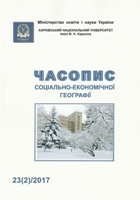Features of population dynamics of Ukraine's regional centres in the post-Soviet period
Abstract
The article analyzes dynamics of the population and its growth rates for the cities-regional centers of Ukraine in the post-Soviet period, their features and main trends were revealed. The ranking of the regional centers of the state according to the population in 1991 and 2017 has been carried out, changes have been analyzed. The regional centers of Ukraine have been mapped according to the indicator of population growth (in absolute and relative terms) for the period of 1991-2017. Grouping of regional centers of Ukraine in terms of population in 1991 and 2017 has been conducted and highlighted big, significant cities and cities-millionaires; composition of the selected groups and the changes occurred have been analyzed. The regional centers of Ukraine have been grouped according to the population growth rates, absolute population growth, duration of the period with the negative and positive dynamics of the population, the main trends in the dynamics of population during 1991-2017. A group of the regional centers of the state with predominance of the negative population dynamics has been highlighted, and within it – cities with constant decrease of population and a cities with an unstable decrease in population. Also, a group of the regional centers of Ukraine with predominance of the positive dynamics of the population has been highlighted, and within it – cities with stable increase in the population in the XXI century and cities with negative trends of the population in the last few years. The periods with the lowest and the highest growth rates of population of the regional centers of Ukraine in the post-Soviet period have been revealed. It has been determined which regional centers of Ukraine can be considered as «crisis» or «depressive» ones by the indicator of population losses during the years of independence.
Downloads
References
2. Derzhavna sluzhba statystyky Ukrainy [State Statistics Committee of Ukraine]. Available at: http://www.ukrstat.gov.ua/
3. Melnyk, I.H. (2017). Dynamichni aspekty rozvytku velykykh mist Ukrainy [Dynamic aspects of development of Ukrainian big cities]. Region-2017: optimal development strategy (2017, September 19‒20). Kharkiv, Ukraine: V.N. Karazin Kharkiv National University, 106-108.
4. Melnyk, I. (2017). Miski poselennya Luhanshchyny: novi vyklyky na foni starykh problem [Urban settlements of Lugansk region: new challenges against the background of old problems]. Urban Ukraine. In the Epicenter of Spa-tial Changes. Kiev, Ukraine: Phoenix, 121-142.
Copyright (c) 2017 Наталія Гусєва

This work is licensed under a Creative Commons Attribution 4.0 International License.




